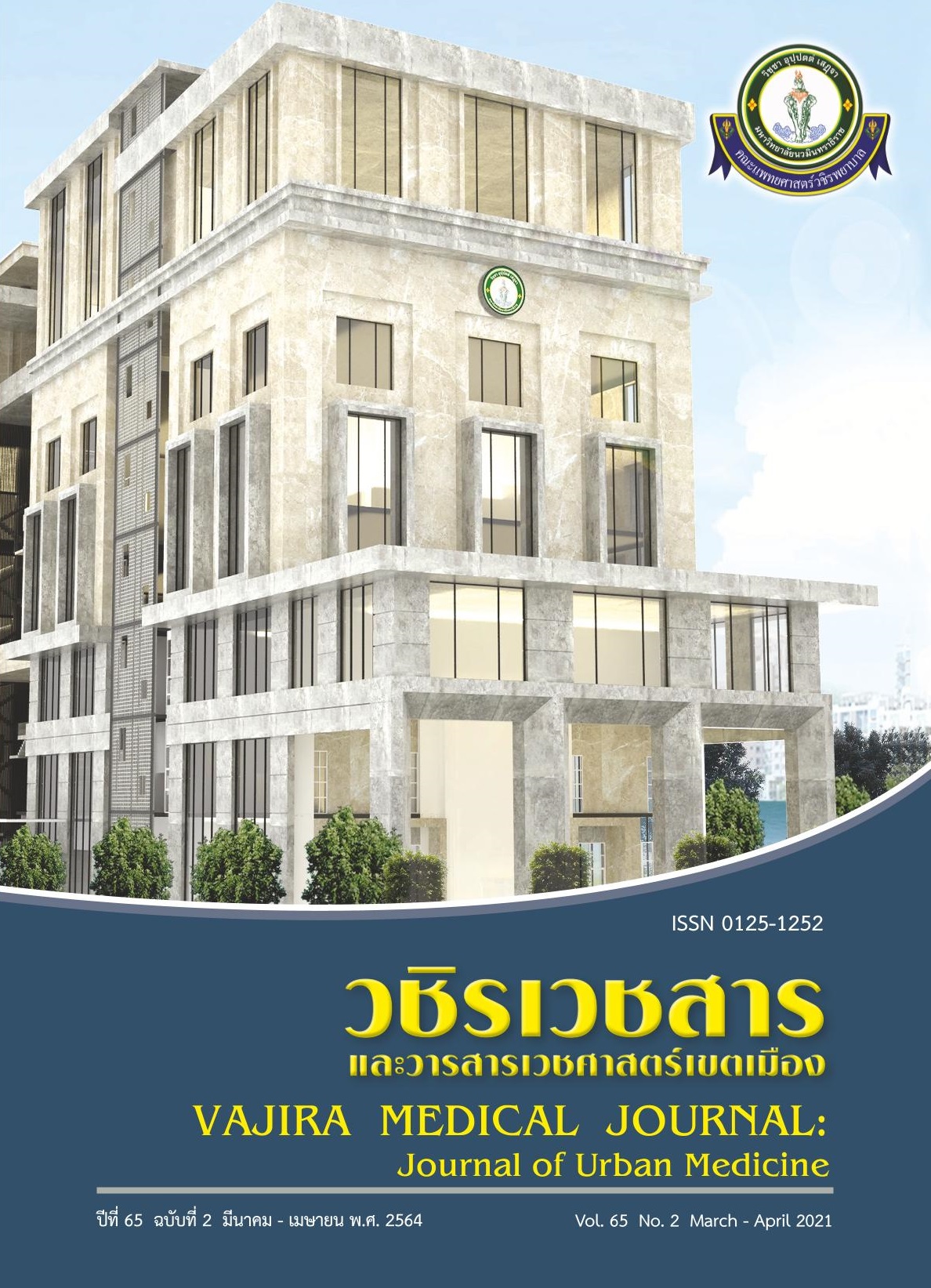A Comparative Study between Modified Kakita Pancreaticojejunostomy and Conventional Reconstruction after Pancreaticoduodenectomy: A Retrospective Review
Main Article Content
Abstract
Background: Advances in surgical techniques and appropriate perioperative management has decreased the mortality rate of pancreaticoduodenectomy less than 5 percent. However, postoperative pancreatic fistula is the most serious and life-threatening condition with the incidence rate at 27% for conventional reconstruction. A newly modified technique in Japan Kakita pancreaticojejunostomy has been reported that it reduces postoperative pancreatic fistula; however there were only few reports of this technique outside Japan. This study aimed to compare rate of pancreatic leakage between the new technique and conventional pancreaticojejunostomy after pancreaticoduodenectomy in Thai patients.
Methods: Data of 25 consecutive patients with periampullary cancer and benign conditions (e.g. chronic pancreatitis) who underwent pancreaticoduodenectomy at Vajira hospital from 2005 to 2015 were reviewed. Postoperative results of fifteen patients who underwent conventional pancreaticojejunostomy (group A) were compared with ten patients who underwent modified Kakita pancreaticojejunostomy (group B). The primary outcome measure was the rate of postoperative pancreatic fistula (POPF) and secondary outcomes included; operative data, postoperative morbidity, mortality and evaluation of the risk factors of pancreatic leakage.
Results: There were no differences in clinicopathological characteristics and postoperative morbidity between two groups. Overall, the leakage rate was 32% (8/25). The pancreatic leakage in group A was 50 % (5/10) while the leakage rate in group B was 20% (3/15), p=0.194. Duration of hospital stay in group A was 39 days (17-66 days) and in group B was 28 days (21.5-46.5 days); p = 0.824. All of the complications could be managed by conservative measures. Intraoperative blood loss was a risk factor for leakage (1500 ml vs. 750 ml, p = 0.038). The leakage caused delayed gastric emptying (3 vs. 0, p = 0.24) and prolonged hospital stay (72.5 days vs. 25.5 days, p< 0.0001).
Conclusion : This retrospective single-center study showed that duct-to-mucosa anastomosis by modified Kakita technique was a safe procedure.
Downloads
Article Details
References
Hosotani R, Doi R, Imamura M. Duct to mucosa pancreaticojejunostomy reduces the risk of pancreatic leakage after pancreatoduodenectomy. World J Surg 2002;26:99-104.
Satoi S, Toyokawa H, Yanagimoto H, Yamamoto T, Yamao J, Kim S, et al. A new guideline to reduce postoperative morbidity after pancreaticoduodenectomy. Pancreas 2008;37(2):128-33.
Traverso W, Wada K. Pancreatic anastomotic leak after the whipple procedure is reduced using the surgical microscope. Surgery 2006;139:735-42.
Kakita A, Takahashi T, Yoshida M, Furuta K. A simpler and more reliable technique of pancreatojejunal anastomosis. Surg Today 1996;26(7):532-5.
Satoi S, Toyokawa H, Yanagimoto H, Yamamoto T, Hirooka S, Yui R, et al. Is a nonstented ductto-mucosa anastomosis using the modified kakita method a safe procedure?. Pancreas 2010; 39(2):165-70.
Bassi C, Dervenis C, Butturini G, Fingerhut A, Yeo C, Izbicki J, et al. Postoperative pancreatic fistula: An international study group (ISGPF) definition. J Surg 2005;138(1):8-13.
Graggen KZ, Uhl W, Friess H, Buchler MW. How to do a safe pancreatic anastomosis. J Hepatobiliary Pancreat Surg 2002;9:733-7.
Bassi C, Falconi M, Molinari E, Mantovani W, Butturini G. Duct to mucosa versus end to side pancreaticojejunostomy reconstruction after pancreaticoduodenectomy: result of a prospective randomized trial. Surgery 2003;134:766-71.
You DD, Jung KU, Lee HG, Heo JS, Choi SH, Choi DW. Comparison of different pancreatic anastomosis techniques using the definitions of the international study group of pancreatic surgery. Pancreas 2009;38(8):896-902.
Kakita A, Yoshida M, Takahashi T. History of pancreaticojejunostomy in pancreaticoduodenectomy: development of a more reliable anastomosis technique. Journal of HBP Surgery 2001;8:230-7.
Gouma DJ, Geenen RC, Gulik TM, Haan RJ, Wit LT, Busch OR, et al. Rates of complications and death after pancreaticoduodenectomy: risk factures and the impact of hospital volume. Annuals of Surgery 2000;232(6):786-95.
Yang YM, Tian XD, Zhuang Y, Wang WM, Wan YL, Huang YT. Risk factors of pancreatic leakage after pancreaticoduodenectomy. World J Gastroenterol 2005;11(16): 2456-61.


